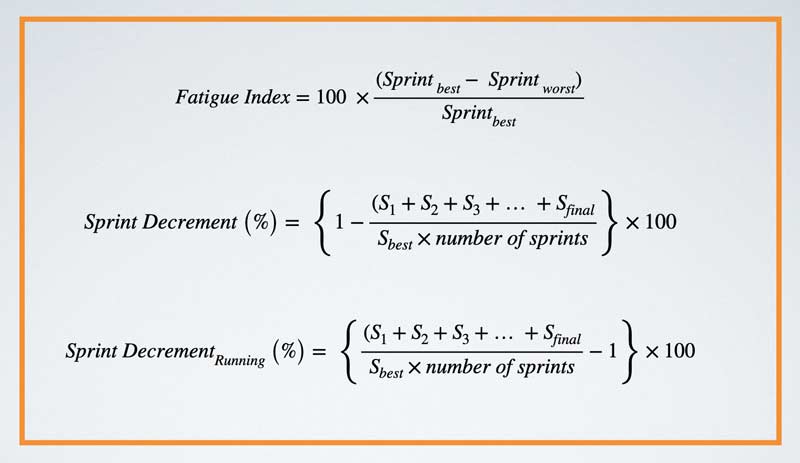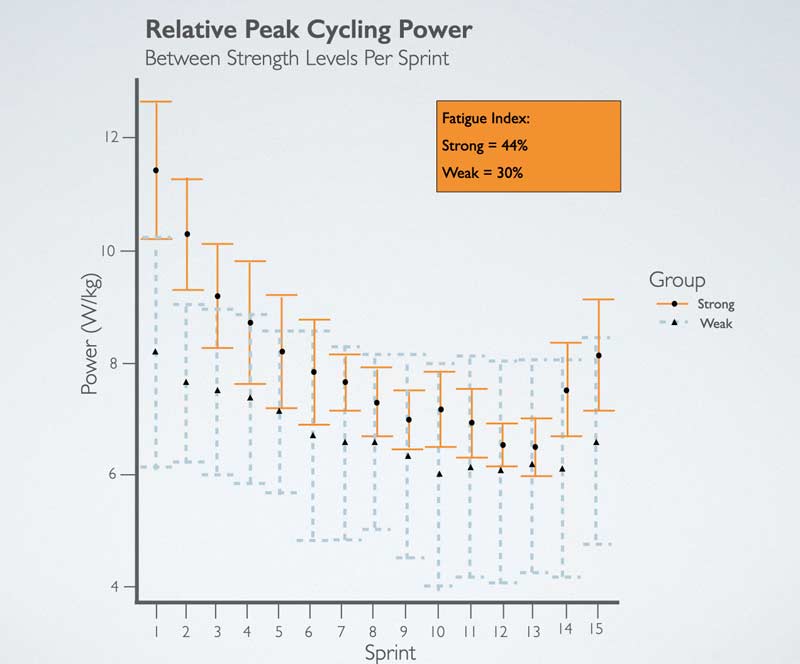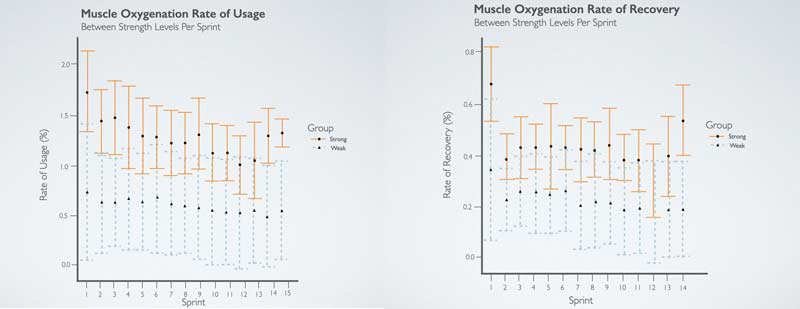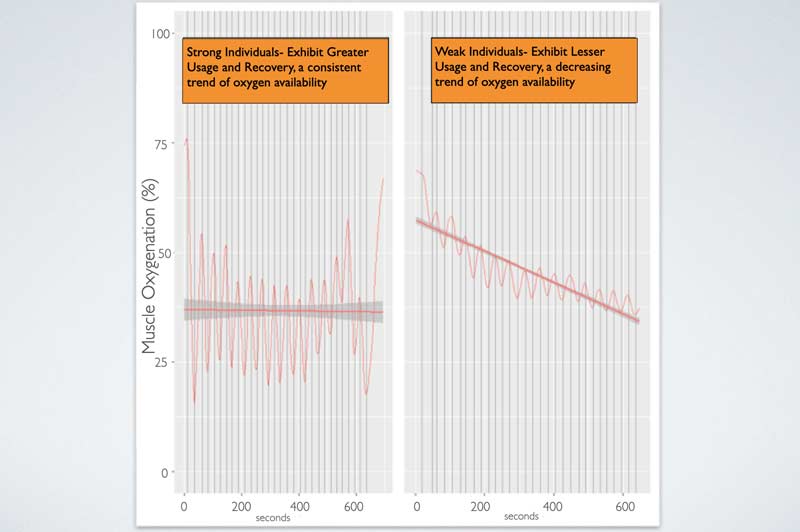The ability to perform multiple repetitions of sprints or other high-intensity movements with limited rest intervals is paramount for field and court sport athletes. Successful repeated sprint performance is dependent on a balance of conflicting components of physical fitness, such as muscular strength/power and muscular-cardiovascular endurance.1There is a requisite level of endurance capability to participate in field and court sports such as soccer, lacrosse, or hockey. However, to be successful in such sports, an athlete must be able to perform multiple bursts of high-intensity movements—primarily linear sprints, but also including change of direction, curvilinear sprints, and jump actions.
Common Measures of RSA
There are numerous repeated sprint ability (RSA) protocols, and they typically include:
- 5-15 repetitions;
- 5- to 15-second active duration;
- 10- to 30-second recovery; and
- Maximal intensity effort with each trial.
Athletes typically are tested free running, on a treadmill, or on a cycle ergometer. In a practical session, the most common variables measured during running RSA include maximal velocity and/or distance covered. Instrumented cycle ergometers allow for the measurement of peak power output, mean power output, and rates of power development. Occasionally, physiological measures are also taken, such as heart rate and lactate, and respiratory responses are paired with biomechanical measures for intensity and possible changes in efficiency. If you look through the literature, you’ll find that every piece of testing equipment can be applied to RSA, though it can create an incoherent stack of data leading to paralysis by analysis.
RSA performance can be characterized by the amount of distance or work completed or by the amount of performance decline, such as fatigue index or percent decrement. Share on XRSA performance can be characterized by the amount of distance or work completed or by the amount of performance decline, such as fatigue index or percent decrement. It is easy to start testing and throwing numbers into these equations, but you need caution and careful interpretation to deduce what these numbers mean. Would you rather an athlete who, after several sprints, is significantly slower than on their first sprint but remains higher than their cohort, or an athlete who maintains similar speeds throughout several sprints but is always slower than their cohort?
The above equations only give you half of the picture—fatigue; they lack the ability to provide insight on meaningful performance. Anaerobic power, highest/best, and power/velocity performed have been found to be the strongest predictor of repeat sprint ability when compared to VO2 maximal velocity at the onset of blood lactate accumulation (a metabolic transitionary threshold associated with increased reliance on anaerobic metabolism), percent decrement, anaerobic capacity (mean velocity or power output), or peak lactate production2. When you really dig into the literature, you will find that out of the several training studies available, none of them truly train maximal strength or evaluate applicable maximal strength test as a factor in RSA.
I directed my graduate research to maximal strength and RSA. I evaluated different physiological and biomechanical responses to 15 repeated sprints. The sprint-to-rest ratio was 10:30 seconds, and groups were based on allometrically scaled peak force from an isometric mid-thigh pull test—a test of maximal strength and rates of force development.


The Ignored Measure for RSA – Strength
Most coaches and athletes I have met are hesitant to implement resistance training due to two main fears: 1) added body mass; and 2) increased rate of fatigue (fatigue index). There are multiple research studies that boast benefits from resistance training. However, most if not all of them target strength endurance (also associated with hypertrophic responses) and fail to consider the beneficial adaptations from maximal strength training. The benefits of maximal strength training for sprinting and endurance-based running are plentiful, though the gap in evidence for RSA fueled my research interest. Long story short, strong athletes compared to weak athletes of similar VO2 peaks and training history produce/exhibit more advantageous results/responses.
Long story short, strong athletes compared to weak athletes of similar VO2 peaks and training history produce/exhibit more advantageous results/responses. Share on XThese responses include:
- Absolute anaerobic power (cycling peak power)
- No statistical difference in fatigue index between strong and weak
- Relative anaerobic power (cycling peak power)
- No statistical difference in fatigue index between strong and weak
- Absolute anaerobic capacity (cycling mean power)
- No statistical difference in fatigue index between strong and weak
- Relative anaerobic capacity (cycling mean power)
- No statistical difference in fatigue index between strong and weak
- Muscle oxygen recovery and rate of recovery
- Muscle oxygen usage and rate of usage


Train Slow Athletes to Repeat Slowness or Fast-Track Your Athletes for Success
Carl Valle discusses RSA and highlights effective testing and training methods for improving player performance rather than test performance. He hits the nail on the head when he states “… first you must be fast. How an athlete fatigues is only interesting if you plan to change something after you analyze the data.” I want to take the rest of the article to discuss some limitations of RSA, as well as how strength and resistance training can boost RSA. There is no doubt that strength and, more importantly, rates of force development (RFD) are limiting factors for maximal sprint performance.
The exact cause of fatigue during RSA remains elusive. The current belief is that fatigue develops due to a culmination of physiological factors, including:
- Neural fatigue;
- Depleted energy supply including alterations to the phosphocreatine adenosine triphosphate system (PCr-ATP), anaerobic glycolysis, and oxidative metabolism;
- Metabolite accumulation; and
- Muscle excitation1.
Improving anaerobic power would be most influential on optimizing RSA. Anaerobic power is augmented by improving the ability to produce work rapidly.3 Work is related to force production; therefore, increasing force production should increase anaerobic power. This is clear when appreciating jump performance as a measure of anaerobic power. Stronger athletes produce greater power than weaker counterparts in weighted and non-weighted jump testing.4,5
It is best to improve strength in an athlete through a logically organized and sequenced training plan. An ideal plan will be all-encompassing and synergistic and include appropriate stimulus for adaptation (resistance training, conditioning, skill practice); appropriate means to assess progress (monitoring systems); and planned rest-recovery phases, psychological reinforcement, daily nutrition, supplements, sleep, etc.6
Dealing with Fuel Depletion and Metabolic Acidosis
Repeat sprinting is an extreme metabolic stressor. This is repeatedly demonstrated by extended exposure to high levels of metabolic acidosis associated with elevated lactate levels, low levels of local oxygen availability, and, in response, high levels of ventilation. A major purpose of repeat high-intensity running drills is to expose athletes to metabolic stimuli that drive adaptations, such as increased buffering capacity, as well as increased PCr and glycogen storage7.
The long-lasting fatigue, deformation of optimized technique, and potential for injury from repeat high-intensity running drills do not outweigh the benefits they may provide. Share on XTypically, exercises associated with these adaptations include, but are not limited to, repeated sprints, stair running, sled drags, and prowler pushes. The long-lasting fatigue, deformation of optimized technique, and potential for injury from these exercises do not outweigh the benefits they may provide. My approach to eliciting these same adaptations includes surgical-like precision in planning and execution.
You can use programming tactics to achieve adaptations while maintaining other traits with a fluctuation of concentrated and retaining loads—for example, seamless sequential integration8. These paradigms include logically sequenced concentrated loads that potentiate one another, with varying emphasis on desired qualities. Periods of general preparation, where training specificity is relatively low and usually accompanied by lower running volumes, typically include larger training volumes in the weight room. These larger training volumes have two major purposes: 1) accumulating training volume and work capacity (training to train); and 2) potentiating gains in strength and power during later blocks.
This phase is commonly associated with larger rep/set ranges at lower intensities (in comparison to 1 repetition maximums); for example, three sets of 10 repetitions of full range-of-motion complex lifts, such as the barbell back squat. High-volume resistance training has been linked to increased power output and repeat sprint ability. Along the same lines, there are strong correlations (that grew stronger) between maximal strength (1RM) and cycling peak power, average power of 15 rides, and average accomplished work over 15 rides (figure 3). What does this mean? Stronger athletes will be more valuable and do more for your team throughout a game, season, and quadrennial as you seek out championships.
If you have novice athletes with little to no training history, you can help foster the longevity of their career by boosting their strength, buffering capabilities, and overall endurance in the weight room. Why would you do this? Providing the athlete with a basic level of strength, work capacity, and body awareness that is adopted through resistance training will reap larger benefits when performing skill development drills. Too often, skill development drills lose their purpose when athletes are: 1) unable to maintain the intensity required and the drill regresses to a conditioning drill; and 2) unable to maintain the positions or posture required to further develop a skill such as sprinting.
Increases in work capacity can include alterations in metabolic efficiency. Following a 12-week plan of resistance training (three days per week, 3×10, bench press, hip flexor knee extension, knee flexion, push-up, leg press, lat pulldown, arm curl, parallel squat, and sit-up) elicited a 12% increase in lactate threshold9. Furthermore, a 10-week resistance training program targeting leg and hip strength improved maximal strength (20%–38%) and increased time until exhaustion of a cycle ergometer test. Continuing high-volume resistance training increased power output and repeat sprint ability.10
Resistance Training and Neural Adaptations
Most studies that evaluate the effects of resistance training on RSA utilize relatively light loading and high-volume schemes that primarily elicit metabolic adaptations11,12. These training methods were found to increase RSA primarily through metabolic alterations. These improvements are valuable, though they are only a drop in the bucket of potential gains. When resistance training is programmed as an additive metabolic conditioning stimulus—aka larger set/repetition schemes combined with minimized rest intervals—minimal strength gains will be observed.
As we challenge our body to learn new skills, our brain undergoes biochemical processes to alter the number and type of motor units activated, the synchrony of recruitment, and the rate coding. Share on XUntrained or weak individuals will more rapidly exhibit gains in strength and power due to neurological adaptations. Neural adaptations are vital to develop, as they are directly influential to force generation. As we challenge our body to learn new skills, such as producing force, our brain undergoes biochemical processes to alter the number and type of motor units activated, the synchrony of recruitment, and the rate coding (the frequency of motor unit activation).
A motor unit is simply a single nerve and all the muscle fibers that it innervates. A whole muscle is comprised of hundreds to thousands of motor units. While that seems simple, there is a complex interaction that occurs between motor unit recruitment and inhibition that allows for movement to occur. Resistance training by repeatedly exposing an athlete to concentrated loads can alter the efficiency of these recruitment strategies.
Henneman’s size principle describes how motor unit recruitment is dependent upon force production. You may be familiar with the spectrum of muscle fiber types, from slow (type I) through fast (type IIx). These different muscle fiber types require different levels of activation in order to contract.
For instance, type IIx has the highest threshold for recruitment, making it the most difficult to activate. The task demand creates high force outputs that best recruit type II muscle fibers. Using maximal strength training will create an opportunity to expose an athlete to a force production overload that they would not otherwise see in training. With concentrated training loads, this training will elicit adaptations that allow for easier activation of these units, such as modifications to the motor-endplate receptor density, quanta of neurotransmitter stored, and efficiency of neurotransmitter release and reuptake.
Neurological efficiency is also gained by enhancing the peripheral neural network to promote intramuscular coordination and intermuscular coordination. Initially, strength gains within a muscle occur by increasing the number of motor units (muscle fibers) recruited. Trained individuals can further improve their intramuscular coordination by increasing synchronization of motor unit activation.
Strength training has been found to increase motor unit synchronization, which increases rates of force development and, therefore, contraction efficiency. Intermuscular coordination—the interaction between primary muscles, synergistic muscles, and antagonistic muscle groups—also improves with resistance training. The brain coordinates multiple groups of muscles to accomplish a task, thus increasing the synchronization of activation between prime movers, which will boost peak force and, more importantly, RFD and economy.
Antagonistic muscle groups resist the forces of a movement. This means that the force required to complete a task is increased if the antagonistic muscles remain active. Following the trend of this paper, resistance training can lead to beneficial adaptations. The concept of further reducing antagonistic input thought training will allow for greater contraction velocities and performance13.
The above-mentioned training effects from improving strength—in particular, maximal strength—lead to enhanced work capacity, buffering properties, and neural control, which are thought to increase repetitive maximal or near maximal power output. It is nearly impossible to replicate the stimuli that are imposed during resistance training without the use of resistance training. I highlighted work capacity and maximal strength adaptations from resistance training; however, the two concentrated loads used to elicit these adaptations are contradictory if completed simultaneously.
For optimal preparedness during the most important time of the season, you should plan a logical sequence of phases with complementary concentrated loads that potentiate one another. Share on XA logical sequence of phases should be planned with complementary concentrated loads that potentiate one another, leading to optimal preparedness during the most important time of the season. For a field or court sport, this may include:
- General Preparation Phase:
- Non-Sport-Specific:
- Reduced running volumes
- Increased resistance training volumes
- Less resistance training intensity
- Goals:
- Reduced impactful collisions (with other players or the ground)
- Post season recovery
- Muscular biochemical adaptations (glycogen storage, buffering capacity, aerobic and anaerobic enzyme activity)
- Muscular architectural adaptions (increased CSA and pennation angles)
- Special Preparation (Transmutation):
- Increased sport-specific volume (running)
- Reduced resistance training volume (approximately three sets of five reps)
- Increased resistance training intensity
- Goals:
- Transfer weight room work capacity on the field or court and augment with running volume
- Develop basic strength-related qualities
- Overload neural drive
- Competition Phase
- Primarily sport-specific volume
- Approaching maximal resistance training intensity
- Further reducing resistance training volume
- Goals:
- Develop maximal strength
- Develop maximal power
- Increase preparedness (fitness-fatigue model)
- WIN
- Non-Sport-Specific:
Since you’re here…
…we have a small favor to ask. More people are reading SimpliFaster than ever, and each week we bring you compelling content from coaches, sport scientists, and physiotherapists who are devoted to building better athletes. Please take a moment to share the articles on social media, engage the authors with questions and comments below, and link to articles when appropriate if you have a blog or participate on forums of related topics. — SF
References
1. Girard, O., Mendez-Villanueva A., and Bishop, D. “Repeated-sprint ability – Part I: Factors contributing to fatigue.” Sports Medicine. 2011;41(8):673-694.
2. da Silva, J. F., Guglielmo, L. G., and Bishop, D. “Relationship between different measures of aerobic fitness and repeated-sprint ability in elite soccer players.” The Journal of Strength & Conditioning Research. 2010;24(8):2115-2121.
3. Cometti, G., Maffiuletti, N., Pousson, M., Chatard, J.-C., and Maffulli, N. “Isokinetic strength and anaerobic power of elite, subelite and amateur French soccer players.” International Journal of Sports Medicine. 2001;22(1):45-51.
4. Beckham, G., Suchomel, T., Sole, C., et al. “Influence of Sex and Maximum Strength on Reactive Strength Index-Modified.” Journal of Sports Science & Medicine. 2019;18:65-72.
5. Kraska, J. M., Ramsey, M. W., Haff, G. G., et al. “Relationship between strength characteristics and unweighted and weighted vertical jump height.” International Journal of Sports Physiology and Performance. 2009;4(4):461. doi:10.1123/ijspp.4.4.461
6. DeWeese, B. H., Hornsby, G., Stone, M., and Stone, M. H. “The training process: Planning for strength–power training in track and field. Part 1: Theoretical aspects.” Journal of Sport and Health Science. 2015;4(4),308-317. doi:https://doi.org/10.1016/j.jshs.2015.07.003
7. Haff, G. G. and Triplett, N. T. Essentials of Strength Training and Conditioning, 4th edition. Human Kinetics, Inc. 2015.
8. Wagle, J. P., Bingham, G. E., DeBusk, C. A., Lee, A. D., and DeWeese, B. H. “Seamless Sequential Integration as a Comprehensive Means of Advanced Athlete Preparation: A Case Study. Coaches College Conference, 2016.
9. Marcinik, J. E., Potts, F. J., Schlabach, F. G., Will, F. S., Dawson, F. P., and Hurley, F. B. “Effects of strength training on lactate threshold and endurance performance.” Medicine & Science in Sports & Exercise. 1997;23(6):739-743. doi:10.1249/00005768-199106000-00014
10. Robinson, M. J., Stone, H. M., Johnson, L. R., Penland, M. C., Warren, J. B., & Lewis, D. R. “Effects of Different Weight Training Exercise/Rest Intervals on Strength, Power, and High Intensity Exercise Endurance.” Journal of Strength and Conditioning Research. 1995;9(4): 216-221. doi:10.1519/00124278-199511000-00002
11. Edge, J., Hill-Haas, S., Goodman, C., and Bishop, D. “Effects of resistance training on H+ regulation, buffer capacity, and repeated sprints.” Medicine and Science in Sports and Exercise. 2006;38(11),2004-2011.
12. Hill-Haas, S., Bishop, D., Dawson, B., Goodman, C., and Edge, J. “Effects of rest interval during high-repetition resistance training on strength, aerobic fitness, and repeated-sprint ability.” Journal of Sports Sciences. 2007;25(6):619-628.
13. Geertsen, S. S., Lundbye-Jensen, J., and Nielsen, J. B. “Increased central facilitation of antagonist reciprocal inhibition at the onset of dorsiflexion following explosive strength training.” Journal of Applied Physiology. 2008;105(3):915-922.





